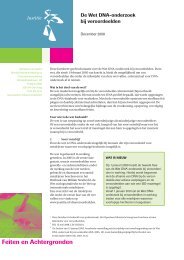INTERPOL HANDBOOK ON DNA DATA EXCHANGE AND PRACTICE
INTERPOL HANDBOOK ON DNA DATA EXCHANGE AND PRACTICE
INTERPOL HANDBOOK ON DNA DATA EXCHANGE AND PRACTICE
You also want an ePaper? Increase the reach of your titles
YUMPU automatically turns print PDFs into web optimized ePapers that Google loves.
Table1 (continued)biologicalmaterialsFaecesFingernailsFingerprintsFleshNasal orear secretionsParts ofbodiesSalivaSemenSkin cellsSweatUrineVaginal fluidhow to isolate and analyse for dnaStandard methods of <strong>DNA</strong> analysis are unsuitable for analysing faeces, unlessmixed with blood, but mitochondrial <strong>DNA</strong> analysis can be used.A <strong>DNA</strong> profile can either be obtained from the skin and blood cells thatcan gather under a nail, if a victim scratched the attacker, or from the actualfingernail as the nail contains sufficient quantities of <strong>DNA</strong> for analysis.It may be possible to obtain a profile by swabbing the residue left behind afterretrieving a fingerprint and then examining it using the LCN <strong>DNA</strong> analysistechnique.Pieces of flesh may be encountered where an individual has been injured. Thistype of sample will contain large quantities of <strong>DNA</strong> and will be suitable foranalysis.Used handkerchiefs and cotton swabs where there are obvious nasal or earsecretions, may be a good source of <strong>DNA</strong>.Parts of bodies are sometimes encountered at scenes, often in poor condition.However, there is still the potential for <strong>DNA</strong> analysis.Saliva staining may, or may not, be visible. There is no <strong>DNA</strong> in saliva itself, but<strong>DNA</strong> is present in the mouth cells that are shed into the saliva.Semen may be found as a liquid (e.g. in a condom) or as visible staining. Itmay also be present but not visible and its possible location may have to beassumed when deciding what items to submit to the laboratory. Liquid semenand even very small semen stains usually contain many sperm, each of whichcontains <strong>DNA</strong>. Even where the semen contains no sperm there may still besufficient cellular material for <strong>DNA</strong> analysis.It is possible, through touching or handling objects or by wearing garments,that a person’s <strong>DNA</strong> will transfer from the donor to the object or garment.This is sometimes referred to as ‘contact trace <strong>DNA</strong>’. Whether it is likely tobe found varies considerably on the circumstances but it can be consideredfor probative objects in serious cases.This is a liquid secretion and contains no <strong>DNA</strong> material. In cases wherelaboratories have been successful in obtaining <strong>DNA</strong> from sweat-stained areason clothing, this has been attributed to the coincidental presence of cells.Urine may contain cells from the lining of the urethra, although it is unlikelythat there will be enough cells for <strong>DNA</strong> analysis.Vaginal fluid will contain cells from the lining of the vagina and is suitable for<strong>DNA</strong> analysis.PAGE 22<strong>DNA</strong> SAMPLING<strong>AND</strong> EVIDENCE COLLECTI<strong>ON</strong>







